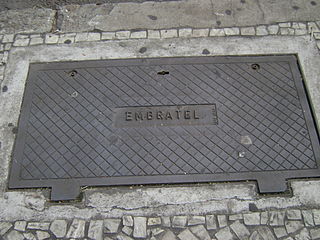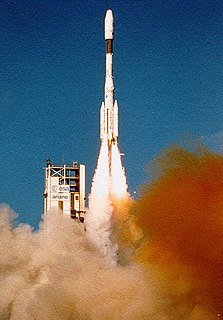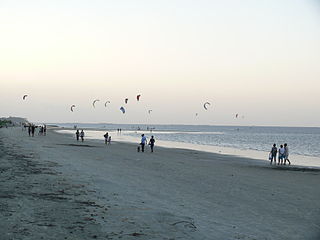
Cerise was a French military reconnaissance satellite. Its main purpose was to intercept HF radio signals for French intelligence services. With a mass of 50 kg, it was launched by an Ariane rocket from Kourou in French Guiana at 17:23 UT, 7 July 1995. Cerise's initial orbital parameters were period 98.1 min, apogee 675 km, perigee 666 km, and inclination 98.0 deg.
Telkom-2 is a C-band geosynchronous communications satellite built by Orbital for Indonesia's state-owned telecommunications company, PT Telekomunikasi Indonesia Tbk. TELKOM-2 was successfully launched November 16, 2005, and positioned in geosynchronous orbit, 22,300 miles above the Earth, at 118°E.
Brasilsat B1 is a Brazilian communications satellite launched on August 10, 1994, by an Ariane rocket model 44L at Guiana Space Centre which is located in Kourou, French Guiana.
HYLAS is a British satellite in geostationary orbit. HYLAS, which is an acronym for Highly Adaptable Satellite, is a communications satellite and was launched by the European Ariane 5 launch vehicle from the Guyana Space Centre at Kourou in French Guiana. It is located at the orbital location of 33.5 degrees west and will provide new and innovative services including High Definition Television (HDTV) and interactive satellite delivered broadband services. The satellite will help address the issue of poor broadband coverage in many parts of Europe which have less developed ground infrastructure.

Artemis was a geostationary earth orbit satellite (GEOS) for telecommunications, built by Alenia Spazio for ESA. The Artemis satellite operated at the 21.5E orbital position until 2016, when it was moved to 123E to cover the L-Band spectrum rights for Indonesia's Ministry of Defense.
EchoStar II is a communications satellite operated by EchoStar. Launched in 1996 it was operated in geostationary orbit at a longitude of 148 degrees west for 12 or 15 years.
Star One B4, originally deignated Brasilsat B4 is a Brazilian communications satellite which is operated by Star One. It was constructed by the Hughes Space and Communications Company, and is based on the HS-376W satellite bus. It was the penultimate HS-376, and final HS-376W to be launched. Its launch was contracted by Arianespace, using an Ariane 4 44LP-3 carrier rocket. The launch occurred at 23:16 GMT on 17 August 2000, from the ELA-2 launch pad at the Guiana Space Centre. The Nilesat 102 satellite was launched on the same rocket.
Star One C3 is a communications satellite operated by Star One, a subsidiary of Embratel. It was built by Orbital Sciences Corporation based on the STAR-2 satellite bus, and was launched on 10 November 2012 21:05 UTC by an Ariane 5ECA carrier rocket, as part of a dual-payload launch with Eutelsat 21B.
Turksat 1B was a Turkish communications satellite as part of a project to form an instant network with two geosynchronous satellites that is supervised by the companies Türksat A.Ş. in Turkey and Aérospatiale of France.
BSAT-1a was a geostationary communications satellite designed and manufactured by Hughes on the HS-376 platform. It was originally ordered and operated by the Broadcasting Satellite System Corporation (B-SAT). It was used as the main satellite to broadcast television channels for NHK and WOWOW over Japan. It had a pure Ku band payload and operated on the 110°E longitude until it was replaced, along its backup BSAT-1b, by BSAT-3a. On 3 August 2010, it was decommissioned and placed on a graveyard orbit.
Brasilsat B2 is a Brazilian communications satellite launched on March 28, 1995, by an Ariane rocket model 44L at Kourou in French Guiana.
BSAT-1b was a geostationary communications satellite designed and manufactured by Hughes on the HS-376 platform. It was originally ordered and operated by the Broadcasting Satellite System Corporation (B-SAT). It was used as backup of BSAT-1a to broadcast television channels for NHK and WOWOW over Japan. It had a pure Ku band payload and operated on the 110°E longitude until it was replaced, along its twin BSAT-1a, by BSAT-3a.
SBS 6 was a geostationary communications satellite designed and manufactured by Hughes on the HS-393 platform. It was originally ordered by Satellite Business Systems, which later sold it to Hughes Communications and was last used by Intelsat. It had a Ku band payload and operated on the 95°W longitude.
Brasilsat B3 is a Brazilian communications satellite. It was launched on 4 February 1998 by an Ariane 44LP carrier rocket, as part of a dual-payload launch with Inmarsat-3 F5. It was built by Hughes Aircraft, based on the HS-376 satellite bus. It operates by Star One, a subsidiary of Embratel.
Brasilsat A2 was a Brazilian geostationary communication satellite belonging to the Brasilsat family. It was built by Spar Aerospace in partnership with Hughes. For most of its useful life it was located in the orbital position of 70 degrees west longitude and was operated by Star One, a subsidiary company of Embratel. The satellite was based on the platform HS-376 and its life expectancy was 8 years. The same was out of commission in February 2004 and was transferred to the graveyard orbit.
Intelsat 701 is a geostationary communication satellite that was built by Space Systems/Loral (SSL). It is located in the orbital position of 29.5 degrees east longitude and it is currently in an inclined orbit. The same is owned by Intelsat. The satellite was based on the LS-1300 platform and its estimated useful life was 15 years.
Intelsat 701 is a geostationary communication satellite that was built by Space Systems/Loral (SSL). It is located in the orbital position of 32.9 degrees east longitude and it is currently in an inclined orbit. The same is owned by Intelsat. The satellite was based on the HS-601 platform and its estimated useful life was 15 years.
Intelsat 706 is a geostationary communication satellite that was built by Space Systems/Loral (SSL). It is located in the orbital position of 157 degrees east longitude and it is currently in an inclined orbit. The same is owned by Intelsat. The satellite was based on the LS-1300 platform and its estimated useful life was 15 years.
Intelsat 707 is a geostationary communication satellite that was built by Space Systems/Loral (SSL). It is located in the orbital position of 53 degrees west longitude and it is currently in an inclined orbit. The same is owned by Intelsat. The satellite was based on the LS-1300 platform and its estimated useful life was 15 years.












